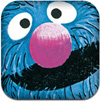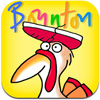 by Melanie D. Koss
by Melanie D. Koss
There something special about sharing a book with a child; turning the pages, pointing to pictures, and enjoying the closeness. But there is a new trend changing the reading experience – children’s book apps. Although both print books and book apps share a story, they are different media and can be used for different purposes. Book apps can make words and stories come to life, allowing a child a different experience with a story. They can aid in comprehension and help children make to connection between words, sounds, and supporting pictures. As technology becomes more integrated into our daily lives, children’s book apps are one way to begin this digital reading process.
What Types of Apps Are Available and How Do We Evaluate Them?
The first thing to think about is why you’re using an app. We’ve identified four major purposes, including using an app solely for reading, as a source of entertainment, to extend the reading experience, or as an educational tool.
One feature to look for is
types of narration. Book apps often contain multiple narration options including Read to Me, Read by Myself, Read and Do, and Read and Record. The Read and Record feature allows the reader to develop a sense of ownership, practice fluency, or record for another listener.
Another feature is animation, including passive and active, each of which requires different levels of engagement. Passive animation includes animation built into the program that does not require interaction. Active animation is designed for interaction between user and app and includes animation activated via actions such as tapping the screen or tilting the device. Other active animations include visual cues or use of additional devices such as webcams and microphones.
App enhancements can include linked glossaries, relevant animation that adds to the text, or the ability to repeat narration. This includes additional scenes or text not found in the print version, or the ability to interact with elements of the pictures to cause images to move and add layers of meaning.
Some apps include educational features designed to impact student learning, including highlighting words as they are read, words or objects narrated when touched, cause and effect sequences, available comprehension activities, and vocabulary support. Also, some apps provide differentiation, including the ability to adjust the reading level of text, the rate of narration, the size of the text, and the availability of alternative output such as sign language.
Extra features and controls to look for include the ability to choose different languages, help buttons, scene selection screens, sound on/off switches, or away to personalize the app with children’s names, photos, or other personal information.
Favorite Apps
 A favorite app example is the classic story The Monster at the End of This Book. This Sesame Street favorite has been adapted to provide a range of reading, entertainment, enhancement, and education opportunities. The words are read aloud and highlighted, and readers can click on a word and have it repeated. On top of the original illustrations and text, readers can tap Grover to make bricks fall, ropes untie, or for him to talk to the reader and add additional comments. If the reader does not click to turn the page, Grover will prompt by saying, for example, “Remember, touching that corner will turn the page, so do not touch it. Do not even look at it. Ack, you’re looking at it!” Additional features such as parent notes are provided.
A favorite app example is the classic story The Monster at the End of This Book. This Sesame Street favorite has been adapted to provide a range of reading, entertainment, enhancement, and education opportunities. The words are read aloud and highlighted, and readers can click on a word and have it repeated. On top of the original illustrations and text, readers can tap Grover to make bricks fall, ropes untie, or for him to talk to the reader and add additional comments. If the reader does not click to turn the page, Grover will prompt by saying, for example, “Remember, touching that corner will turn the page, so do not touch it. Do not even look at it. Ack, you’re looking at it!” Additional features such as parent notes are provided.
 Blue Hat, Green Hat by Sandra Boynton is a well-known app with a variety of interactive elements that add to the print version. It has options for Read to Me or Read it Myself, and when a word is tapped it is highlighted and read aloud. Each animal interacts with its article of colored clothing when tapped, and there is always an extra element with the turkey, such as an explosion of underwear that can then be flicked around the screen.
Blue Hat, Green Hat by Sandra Boynton is a well-known app with a variety of interactive elements that add to the print version. It has options for Read to Me or Read it Myself, and when a word is tapped it is highlighted and read aloud. Each animal interacts with its article of colored clothing when tapped, and there is always an extra element with the turkey, such as an explosion of underwear that can then be flicked around the screen.
 Nosy Crow created a version of The Three Little Pigs that includes a number of features. Unique to this app is a Read and Play version, so the reader can choose whether or not to enable additional interactions. When interactions are enabled, the reader can blow on the microphone to help the wolf blow down the houses, tap on each character to hear characters’ internal thoughts that reveal their individual personalities, and tilt the screen to show more of the background illustrations.
Nosy Crow created a version of The Three Little Pigs that includes a number of features. Unique to this app is a Read and Play version, so the reader can choose whether or not to enable additional interactions. When interactions are enabled, the reader can blow on the microphone to help the wolf blow down the houses, tap on each character to hear characters’ internal thoughts that reveal their individual personalities, and tilt the screen to show more of the background illustrations.
 The Strange and Wonderful World of Ants by Amos Latteier is a nonfiction title strong in differentiation. What makes this app stand out is the ability to change the reading level, which adjusts the difficulty of the vocabulary, the size of the text, the font, and the amount of information provided. Narration is only available for the beginning level. Also available are a glossary, questions, and links to other ant websites.
The Strange and Wonderful World of Ants by Amos Latteier is a nonfiction title strong in differentiation. What makes this app stand out is the ability to change the reading level, which adjusts the difficulty of the vocabulary, the size of the text, the font, and the amount of information provided. Narration is only available for the beginning level. Also available are a glossary, questions, and links to other ant websites.
 There are also apps developed for older readers. One popular book series, Nancy Drew, has been developed into an app series called Nancy Drew Mobile Mysteries. These apps are designed as crossovers between books and games, and have multiple components for interacting with the text. Nancy leads readers on a choose-your-own-adventure, in which they read through 8 chapters, unlock mini-mysteries, and play games that provide additional story information. This app provides glossary and sound supports with certain words highlighted throughout the text.
There are also apps developed for older readers. One popular book series, Nancy Drew, has been developed into an app series called Nancy Drew Mobile Mysteries. These apps are designed as crossovers between books and games, and have multiple components for interacting with the text. Nancy leads readers on a choose-your-own-adventure, in which they read through 8 chapters, unlock mini-mysteries, and play games that provide additional story information. This app provides glossary and sound supports with certain words highlighted throughout the text.
 Chopsticks, a new novel by Jessica Anthony and Rodrigo Corral, is written entirely in photographs, pictures, and other assorted images. Piano prodigy Glory has disappeared and the text is told in flashbacks leading up to her disappearance. The app extends the print version by adding additional images, music, color, and embedded videos, all of which add additional layers of meaning to the already visual text.
Chopsticks, a new novel by Jessica Anthony and Rodrigo Corral, is written entirely in photographs, pictures, and other assorted images. Piano prodigy Glory has disappeared and the text is told in flashbacks leading up to her disappearance. The app extends the print version by adding additional images, music, color, and embedded videos, all of which add additional layers of meaning to the already visual text.
Additional Resources
Additional resources on finding and using apps can be found on the following blogs and websites: Kirkus Reviews, Moms with Apps, Digital Storytime, and the iTunes App Store.
Melanie D. Koss is an assistant professor in the Department of Literacy Education at Northern Illinois University and is a member of the International Reading Association's Children's Literature and Reading Special Interest Group (CL/R SIG).